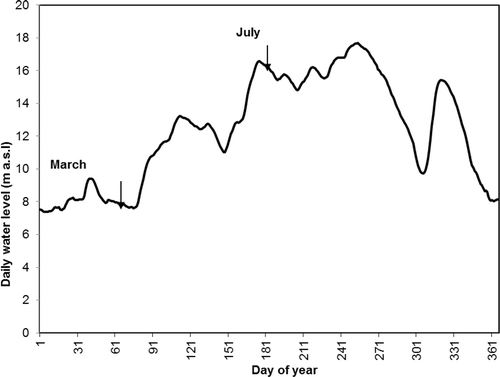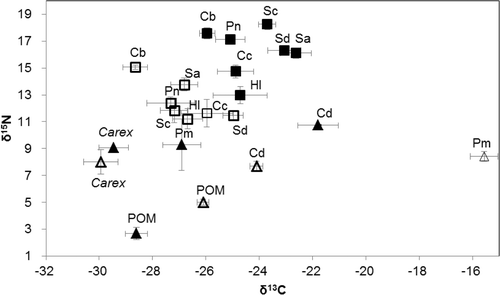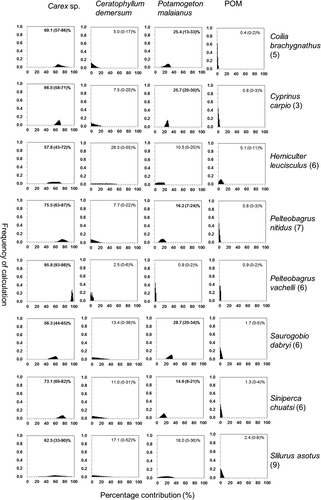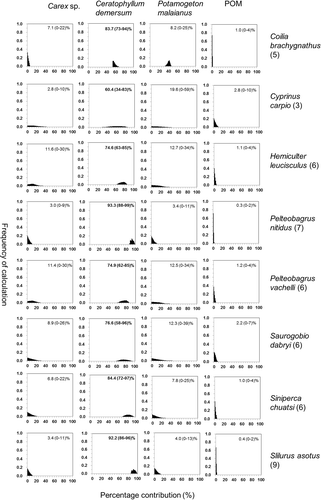Abstract
We compared the stable isotope ratios of δ 13C and δ 15N of four basal food sources and eight fish species collected in spring and summer from the largest freshwater lake in China, Lake Poyang. The aim was to study the temporal variations in the fishes’ energy sources. The δ 13C and δ 15N ratios of all eight species of fish were higher in summer. Employing the IsoSource mixing model, we identified that the terrestrial plant Carex spp. was the most important primary producer supporting fish biomass in spring when the water level was low; meanwhile, the submerged macrophyte Potamogeton malaianus made consistent contributions to fish. However, in summer, when the water level was high, the submerged macrophyte Ceratophyllum demersum was the most important primary production source for fish. Our study indicated that feeding links in floodplain lakes are complex and modified by hydrologic seasonality.
Introduction
Floodplain lakes play an important role in spawning and recruitment and as nurseries and shelter for many fish species (Junk and Wantzen Citation2004; Granado-Lorencio et al. Citation2007; Roach et al. Citation2009). Many chemical and biological factors are affected by seasonal water level fluctuation, and potential energy sources for aquatic food webs may differ between low- and high-water periods (Wantzen et al. Citation2002; Oliveira et al. Citation2006; Zeug and Winemiller Citation2008; Shoup and Wahl Citation2009; Wang, Yu, Li et al. Citation2011a). Available food sources for fish may be limited and less varied during low-water periods, although flooding during high-water periods can bring fish in contact with a greater abundance and diversity of food sources, such as terrestrial plants (Wantzen et al. Citation2002; Junk and Wantzen Citation2004; Zeug and Winemiller Citation2008; Roach et al. Citation2009).
Stable isotope analysis is widely used in studies on food web and trophic relationships, because isotopic signatures of tissues reflect organism diet over time (Xu and Xie Citation2004; Xu et al. Citation2007; Wang, Yu, Xu et al. Citation2011b). The subsequent development of mixing models also provides opportunities to quantitatively trace the contribution of multiple food sources entering the food web (Post Citation2002; Phillips and Gregg Citation2003; Newsome et al. Citation2007). Investigations on multiple stable isotopes (δ 13C and δ 15N) have successfully determined feeding relationships and energy flows in floodplain rivers and lakes (Wantzen et al. Citation2002; Oliveira et al. Citation2006; Herwig et al. Citation2007; Zeug and Winemiller Citation2008; Roach et al. Citation2009). For example, studies on floodplain rivers have demonstrated that terrestrial materials combined with algae production comprise an important energy source apart from macrophytes or phytoplankton (Herwig et al. Citation2004, Citation2007). Stable isotope studies in tropical and temperate floodplain lakes show significant variations in the energy sources of fish as water level varies (Wantzen et al. Citation2002; Reid et al. Citation2008). In addition, C3 plants are the major carbon source for all fish species in the Amazonian floodplain (Oliveira et al. Citation2006). There are few studies on food web dynamics of floodplain lakes in China. In Lake Poyang, China's largest freshwater floodplain lake, only estimates of the potential fish productivity based on the productivity of aquatic macrophytes and phytoplankton have been conducted (Zhu and Zhang Citation1997).
In this study, we measured stable isotope ratios of δ 13C and δ 15N for eight species of fish and some of their potential food sources collected from Lake Poyang in spring and summer to understand temporal variations in the energy base of the lake. Employing the IsoSource mixing model (Phillips and Gregg Citation2003), we also investigated the relative importance of basal food sources for fish.
Methods
Lake Poyang (N 29°03′, E 116°21′), located in southern China, receives flows from five principal tributaries (Fu, Gan, Rao, Xin, and Xiu rivers) and empties into the Yangtze River through a single outlet at Hukou (Zhu and Zhang Citation1997). A major portion of its water comes from these tributaries and from precipitation, both of which are heavily influenced by East Asian monsoonal rain patterns (Shankman et al. Citation2006). It has dramatic annual water-level fluctuations ranging from 8 to 14 m (Zhu and Zhang Citation1997). During the wet season from April to September, water level rises to an average of 17–18 m above sea level (asl) with a surface area of approximately 4000 km2 (). During the dry season from October to March, water level drops to an average of 7–8 m asl, with a corresponding decrease in the lake surface area to less than 1000 km2 (Zhu and Zhang Citation1997). The productivity of primary producers has great seasonal variations (Guan et al. Citation1987; Zhu and Zhang Citation1997; Wang et al. Citation2004). Terrestrial plants have two growth seasons; one before the high-water level in spring and the other after the high-water level in autumn. The aboveground parts of the aquatic macrophytes die as the riparian area dries at low-water time and then emerge again in spring (Guan et al. Citation1987; Cui et al. Citation2000).
Figure 1. Daily water-level changes of Lake Poyang in 2008. The dark triangles indicate the sampling times of this study.

Samples for stable isotope analysis were taken in 2008 during low water in March and high-water in July (). In both seasons, two replicate samples of fresh leaves of the dominant terrestrial plant, Carex spp., were collected by hand. Two kinds of common submerged macrophytes, namely, Ceratophyllum demersum and Potamogeton malaianus, were also collected (Guan et al. Citation1987). Two C. demersum and two P. malaianus samples were collected in spring, and three C. demersum and three P. malaianus samples in summer. Next, 10 and 16 replicate samples of particulate organic matter (POM), a mixture of plankton and suspended POM, were obtained by filtering 1 L of surface lake water onto pre-combusted glass filters (1.2 µm pore size, Whatman® GF/C) in the two seasons, respectively. A total of 153 specimens of 8 common fish species, namely, zooplanktivore Coilia brachygnathus, carnivores Silurus asotus and Siniperca chuatsi, herbivore Hemiculter leucisculus, omnivores Cyprinus carpio, Pelteobagrus nitidus, and Pelteobagrus vachelli, and detritivore Saurogobio dabryi, were collected from the central part of Lake Poyang. Fish were caught by local fishermen using a 5-mm mesh net.
In the laboratory, white muscles were removed from the dorsal region of each fish. These samples were oven-dried at 60°C to constant weight. POM samples were acidified with 1N HCl to exclude possible carbonate contamination and then dried at 60°C for 48 h. Plants were rinsed and then dried at 60°C for 24 h. All dried samples were ground to fine powder using mortars and pestles and then weighed to the nearest 0.001 mg into tin capsules for stable isotope analysis. Analyses of carbon and nitrogen isotopes were carried out using a Finnegan MAT 253 (Thermo Scientific, USA) continuous-flow isotope ratio mass spectrometer coupled with a Flash Elemental Analyzer 1112 (Institute of Geographic Sciences and Natural Resources Research, Chinese Academy of Sciences). Isotope values were expressed as δ 13C and δ 15N (per mil) in the equation:
Reference standards were PeeDee belemnite carbonate for δ 13C and atmospheric N2 for δ 15N. Based on replicates of laboratory standards, analytical precision values were ±0.1‰ and ±0.3‰ for δ 13C and δ 15N, respectively.
The IsoSource procedure described by Phillips and Gregg (Citation2003) was performed to model the relative contributions of basal food sources to consumers in different seasons. A dual-isotope (δ 13C and δ 15N) four-source mixing model was constructed to estimate all possible combinations of each source contribution (0–100%) at increments of 1%. The initial tolerance was set at 0.1‰. If the mixture of the isotope values were out of bounds (i.e., outside of the polygon delineated by the sources), the tolerance value was increased by 0.1%, up to a maximum of 3.0% (Phillips and Gregg Citation2003). The output values were expressed as the mean percentile value followed by the 1st and 99th percentiles. Prior to running the models, isotopic values of fish were corrected for trophic fractionation. We subtracted 3.4‰ from δ 15N values of each consumer species (Post Citation2002).
One-way ANOVA was used for comparing stable isotope data of basal food sources and consumers collected in both seasons. All statistical analyses were performed with SPSS 14.0 (SPSS Inc., Chicago, IL, USA).
Results and discussion
The δ 13C and δ 15N values of the four basal sources were relatively well differentiated in both seasons. Terrestrial plant Carex spp. had the lowest δ 13C values in both spring (−30.0‰) and summer (−29.5‰), whereas the remaining producers were relatively enriched in 13C (). POM exhibited significant seasonal variation in both δ 13C and δ 15N values (). The δ 13C value of P. malaianus was significantly lower in summer (−26.9‰) compared with that in spring (−15.6‰) (). The δ 15N value of C. demersum was significantly enriched in summer (10.7‰) compared with that in spring (7.7‰) (, ).
Figure 2. The δ 13C and δ 15N bi-plot of main producers and consumers collected from Lake Poyang in March and July 2008. Values represent means ±1 SE. White triangles, March primary producers; white squares, March fish; black triangles, July primary producers; and black squares, July fish. Energy sources: Carex, Carex spp.; Cd, C. demersum; Pm, P. malaianus; and POM, particulate organic matter. Fish: Cb, C. brachygnathus; Cc, C. carpio; Hl, H. leucisculus; Pn, P. nitidus; Pv, P. vachelli; Sa, S. asotus; Sc, S. chuatsi; and Sd, S. dabryi.

Table 1. One-way ANOVA comparison of seasonal variations in δ 13C and δ 15N values of producers and consumers.
Fish species collected in summer had a greater range of δ 13C and δ 15N values relative to samples collected in spring. In spring, δ 13C of eight fishes ranged from −30.0‰ to −23.4‰; whereas δ 13C of fish in summer ranged from −32.2‰ to −18.7‰. Except for C. carpio (−26.0‰ in spring, −24.9‰ in summer) and H. leucisculus (−26.7‰ in spring, −24.7‰ in summer), which showed no δ 13C significant variation between seasons, δ 13C values of the other six species of fish were more enriched in summer (all p < 0.05; , ). The significant increase of δ 13C values for fish collected in summer suggested differences in their carbon sources. In spring, δ 15N of eight fishes ranged from 8.8‰ to 15.8‰, while that in summer ranged from 10.0‰ to 21.4‰. Only H. leucisculus (11.2‰ in spring, 13.0‰ in summer) showed no significant δ 15N variations in both seasons; δ 15N values of the other seven species of fish were more enriched in summer (all p < 0.05) (, ).
IsoSource model results (1st to 99th percentile ranges) indicated that the terrestrial plant Carex spp. was the most important basal food source, supporting the biomass of all eight fish species examined in spring with a 1st percentile value range of 33–93% (). Submerged macrophyte P. malaianus also accounted for a significant fraction of assimilated food sources for five fish species (1st percentile value >0). IsoSource model results suggested that two autochthonous sources of biomass (C. demersum and POM) probably made minor contributions in spring, although the 99th percentile values were greater for C. demersum relative to POM (). In summer, C. demersum was the most important contributor for eight fish species, with 1st percentile ranging from 34% to 88% and 99th percentile from 83%to 99% (). Carex spp., POM, and P. malaianus also made minor contributions to the fish examined (). Isotopic mixing model results also indicated that fish assimilated more aquatic food sources in summer than in spring ( and ).
Figure 3. Means and 1st to 99th percentile ranges (in parentheses) of basal food source contributions to fish collected from Lake Poyang in spring. Histograms show the distribution of feasible contributions from each source to fish in spring. For each species, producers with a necessary contribution (1st percentile >0%) are labeled in bold letters.

Figure 4. Means and 1st to 99th percentile ranges (in parentheses) of basal food source contributions to fish collected from Lake Poyang in summer. Histograms show the distribution of feasible contributions from each source to fish in summer. For each species, producers with a necessary contribution (1st percentile >0%) are labeled in bold letters.

Environmental conditions related to seasonal changes in hydrological connectivity affect the availability of alternative primary production sources for fish living in floodplain lakes. The inter-relationship between aquatic and terrestrial environments transports a great variety of food sources to the water column, strongly influencing consumer–resource interactions (Winemiller Citation2005; Oliveira et al. Citation2006; Zeug and Winemiller Citation2008). Terrestrial carbon from the riparian zone was the most important primary production that supported fish biomass in the spring, while it gave minor contributions in summer ( and ). Our results are similar to those presented by studies done on tropical (Wantzen et al. Citation2002; Oliveira et al. Citation2006) and temperate (Zeug and Winemiller Citation2008; Roach et al. Citation2009) floodplain habitats. As low-water conditions result in contraction of aquatic habitats, newly expanded floodplain habitats provide an immediate influx of allochthonous detritus and invertebrates. In low-water periods, the floodplain lake was enriched by detritus from death and decay of terrestrial plants and aquatic macrophytes. In spring, terrestrial plants were the most productive group, accounting for 62.9% of total plant biomass in Lake Poyang, while in summer, submerged macrophytes accounted for 68.0% of the total biomass (Guan et al. 1987). In high-water periods, the water area expansion caused submerged aquatic macrophyte populations to expand in size. The IsoSource model results also indicated that in summer, fish in Lake Poyang shifted to consume mainly submerged macrophyte C. demersum, which were more enriched in δ 15N, thereby leading to further fish enrichment ( and ).
Acknowledgments
We sincerely thank Dr Yuwei Chen, Dr Lu Zhang, and the staff of Lake Poyang Laboratory for Wetland Ecosystem Research, Nanjing Institute of Geography and Limnology, Chinese Academy of Sciences, for their help in the field work and data collection. This study was supported by National Basic Research Program of China (2009CB421106), the National Science and Technology Support Plan (2006BAC08B05), and the National Natural Science Foundation of China (30870428 to Jun Xu). Funding was also awarded to Jun Xu by the K.C. Wong Education Foundation and the Knowledge Innovation Program of the Chinese Academy of Sciences.
References
- Cui , XH , Zhong , Y and Chen , JK . 2000 . Influence of a catastrophic flood on densities and biomasses of three plant species in Poyang Lake, China . Journal of Freshwater Ecology , 15 ( 4 ) : 537 – 541 .
- Granado-Lorencio , C , Cerviá , J and Lima , C . 2007 . Floodplain lake fish assemblages in the Amazon River: directions in conservation biology . Biodiversity and Conservation , 16 ( 3 ) : 679 – 692 .
- Guan , S , Lang , Q and Zhang , B . 1987 . Biomass of macrophytes of the Poyang Lake with suggestions of its rational explantation . Acta Hydrobiologica Sinica , 11 ( 3 ) : 219 – 227 .
- Herwig , BR , Soluk , DA , Dettmers , JM and Wahl , DH . 2004 . Trophic structure and energy flow in backwater lakes of two large floodplain rivers assessed using stable isotopes . Canadian Journal of Fisheries and Aquatic Sciences , 61 ( 1 ) : 12 – 22 .
- Herwig , BR , Wahl , DH , Dettmers , JM and Soluk , DA . 2007 . Spatial and temporal patterns in the food web structure of a large floodplain river assessed using stable isotopes . Canadian Journal of Fisheries and Aquatic Sciences , 64 ( 3 ) : 495 – 508 .
- Junk , WJ and Wantzen , KM . 2004 . The flood pulse concept: new aspects, approaches, and applications – an update , Welcomme RL, Petr T, editors. . Proceedings of the second international symposium on the management of large rivers for fisheries; 2003 Feb 11–14; Mekong River Commission, Phnom Penh, Cambodia. Vol. 2. Bangkok: FAO Regional Office for Asia and the Pacific. p. 117–149
- Newsome , SD , del Rio , CM , Bearhop , S and Phillips , DL . 2007 . A niche for isotopic ecology . Frontiers in Ecology and the Environment , 5 ( 8 ) : 429 – 436 .
- Oliveira , A , Soares , M , Martinelli , L and Moreira , M . 2006 . Carbon sources of fish in an Amazonian floodplain lake . Aquatic Sciences , 68 ( 2 ) : 229 – 238 .
- Phillips , DL and Gregg , JW . 2003 . Source partitioning using stable isotopes: coping with too many sources . Oecologia , 136 ( 2 ) : 261 – 269 .
- Post , DM . 2002 . Using stable isotopes to estimate trophic position: models, methods, and assumptions . Ecology , 83 ( 3 ) : 703 – 718 .
- Reid , DJ , Quinn , GP , Lake , PS and Reich , P . 2008 . Terrestrial detritus supports the food webs in lowland intermittent streams of south-eastern Australia: a stable isotope study . Freshwater Biology , 53 ( 10 ) : 2036 – 2050 .
- Roach , KA , Thorp , JH and Delong , MD . 2009 . Influence of lateral gradients of hydrologic connectivity on trophic positions of fishes in the Upper Mississippi River . Freshwater Biology , 54 ( 3 ) : 607 – 620 .
- Shankman , D , Keim , BD and Song , J . 2006 . Flood frequency in China's Poyang Lake region: trends and teleconnections . International Journal of Climatology , 26 ( 9 ) : 1255 – 1266 .
- Shoup , DE and Wahl , DH . 2009 . Fish diversity and abundance in relation to interannual and lake-specific variation in abiotic characteristics of floodplain lakes of the lower Kaskaskia River, Illinois . Transactions of the American Fisheries Society , 138 ( 5 ) : 1076 – 1092 .
- Wang , TY , Wang , JQ and Wu , JP . 2004 . The comparison of species diversity of phytoplankton between spring and autumn in Poyang Lake . Journal of Fudan University (Natural Science) , 43 ( 6 ) : 1073 – 1078 .
- Wang , YY , Yu , XB , Li , WH , Xu , J , Chen , YW and Fan , N . 2011a . Potential influence of water level changes on energy flows in a lake food web . Chinese Science Bulletin , 56 ( 26 ) : 2794 – 2802 .
- Wang , YY , Yu , XB and Xu , J . 2011b . Decreased trophic position as a function of increasing body size of a benthic omnivorous fish from the largest freshwater lake in China . Environmental Biology of Fishes , 91 ( 4 ) : 505 – 512 .
- Wantzen , KM , de Arruda Machado , F , Voss , M , Boriss , H and Junk , WJ . 2002 . Seasonal isotopic shifts in fish of the Pantanal wetland, Brazil . Aquatic Sciences , 64 ( 3 ) : 239 – 251 .
- Winemiller , KO . 2005 . Floodplain river food webs: generalizations and implications for fisheries management , Welcomme RL, Petr T, editors. . Proceedings of the second international symposium on the management of large rivers for fisheries; 2003 Feb 11–14; Mekong River Commission, Phnom Penh, Cambodia. Vol. 2. Bangkok: FAO Regional Office for Asia and the Pacific. p. 285–309
- Xu , J and Xie , P . 2004 . Studies on the food web structure of Lake Donghu using stable carbon and nitrogen isotope rations . Journal of Freshwater Ecology , 19 ( 4 ) : 645 – 650 .
- Xu , J , Zhang , M and Xie , P . 2007 . Size-related shifts in reliance on benthic and pelagic food webs by Lake Anchovy . Ecoscience , 14 ( 2 ) : 170 – 177 .
- Zeug , SC and Winemiller , KO . 2008 . Evidence supporting the importance of terrestrial carbon in a large-river food web . Ecology , 89 ( 6 ) : 1733 – 1743 .
- Zhu , HH and Zhang , B . 1997 . “ The Lake Poyang ” . In Wetland ecology , Vol. Ch. 7 , 203 – 214 . Hefei : Press of University of Science and Technology of China .